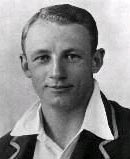

Australia Cricket Players

Donald Bradman
Wisden Cricketer of the Year 1931
Australian Cricket Hall of Fame 1996
Knighted for services to cricket 1949
Appointed Commander of the Order of Australia (AC) 1979
Selected as one of five Wisden Cricketers of the Century, 2000
Sir Donald George Bradman, AC (August 27, 1908 February 25, 2001), often called Don Bradman or The Don, is universally regarded as the greatest batsman of all time, and is one of Australia's most popular sporting heroes. Among those who have a meaningful Test match batting average through batting in more than 20 innings, his figure of 99.94 is over 63% higher than that achieved by any other cricketer. Next among those who have batted in more than 20 innings is South African Graeme Pollock with an average of 60.97.
Born in Cootamundra, New South Wales, but raised in Bowral (where the Bradman Museum and Bradman Oval are located), Bradman practiced obsessively during his youth. At home he invented his own one-man cricket game using a stump and a golf ball. A water tank stood on a brick stand behind the Bradman home on a covered and paved area. When hit into the curved brick stand, the ball would rebound at high speed and varying angles. This form of practice helped him to develop split-second speed and accuracy. After a brief dalliance with tennis he dedicated himself to cricket, playing for local sides before attracting sufficient attention to be drafted into grade cricket in Sydney at the age of 18. Within a year he was selected for New South Wales, and within three years he made his Test debut. After receiving some criticism in his first Ashes series in 19281929 he worked to remove perceived weaknesses in his game, and by the time of the Bodyline series he was without peer as a batsman. Possessing a great stillness whilst awaiting the delivery, his shot making was based on a combination of excellent vision, speed of both thought and footwork and a decisive, powerful bat motion with a pronounced follow-through. Technically his play was almost flawless, strong on both sides of the wicket with only his sternest critics noting a tendency for his backlift to be slightly angled toward the slip cordon.
In the English summer of 1930 he scored 974 runs in only seven innings over the course of the five Ashes Tests, the highest individual total in any Test series before or since. Bradman himself rated his 254 in the second Test at Lord's as his best ever innings. His 334 in the third Test at Headingley, of which he scored a Test record 309 runs on one day, was then the highest individual score in Test cricket (surpassed by Walter Hammond in 1933 but not equalled by an Australian batsman until Mark Taylor declared with his score at 334 not out in 1998, in what many regard as a deliberate tribute to Bradman; Matthew Hayden subsequently broke the record, scoring 380 in 2003). Bradman so dominated the game that special bowling tactics, known as fast leg theory or Bodyline, regarded by many as unsporting and dangerous, were devised by England captain Douglas Jardine to reduce his dominance in a series of international matches against England in the Australian summer of 19321933. The principal English exponent of Bodyline was the Nottinghamshire pace bowler Harold Larwood, and the contest between Bradman and Larwood was to prove to be the focal point of the competition. Some indication of his superlative skill was that his average for that series, 56.57, is still higher than the career averages of all but a dozen or so international Test cricketers. Further evidence of his supreme athletic skills was revealed when Bradman missed the 193536 tour to South Africa due to illness. During his absence from cricket, Bradman took up squash to keep himself fit. He subsequently won the South Australian Open Squash Championship. Despite occasional battles with illness, he dominated world cricket throughout the 1930s, and is credited with raising the spirit of a nation suffering under the privations of the Great Depression.
Approaching forty years of age (most players today are retired by their late-thirties), he returned to play cricket after World War II, leading one of the most talented teams in Australia's history. In his farewell 1948 tour of England the team he led, dubbed "The Invincibles", went undefeated throughout the tour, a feat unmatched before or since. On the occasion of his last international innings, Bradman needed four runs to be able to retire with a batting average of 100, but was dismissed for nought (in cricketing parlance, "a duck") by spin bowler Eric Hollies. Applauded onto the pitch by both teams, it was sometimes claimed that he was unable to see the ball due to the tears welling in his eyes, a claim Bradman always dismissed as sentimental nonsense. "I knew it would be my last Test match after a career spanning twenty years", he said, "but to suggest I got out as some people did, because I had tears in my eyes, is to belittle the bowler and is quite untrue." He was given a guard of honour by the players and spectators alike as he left the ground with a batting average of 99.94 from his 52 Tests.
- Full name : Donald George Bradman
- Born : August 27, 1908, Cootamundra, New South Wales
- Died : February 25, 2001, Kensington Park, Adelaide, South Australia (aged 92 years 182 days)
- Batting style : Right-hand bat
- Bowling style : Legbreak
- Test debut : Australia v England at Brisbane (Exhib.) - Nov 30-Dec 5, 1928
- Last Test : England v Australia at The Oval - Aug 14-18, 1948



